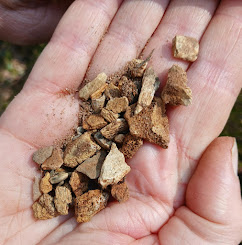This was a very exiting week. During a five day trial excavation we managed to find out a lot more about this well preserved Early Comb Ceramic period dwelling site that was discovered in 2021 by archaeologists Timo Sepänmaa and Johanna Roiha.
The Hiekkaharjuntie stone-age dwelling site photographed from northwest.
The excavation started out in sunny but rather chilly spring weather. The finds during the first two days only consisted of quartz flakes, burnt bone and a small slate chisel which seemed to point towards the site beeing from the Mesolithic rather than the Early Neolithic period.
The first finds from the site, burnt bone and quartz flakes (left) and a small chisel (right).
Soon however we also started finding small fragments of pottery. The shape of the rimsherds and rather coarse ware pointed towards the pottery fragments beeing from the Early Comb Ceramic period (ca 7 000 BP).
Small early comb ceramic potsherds and burnt bone from one of the test pits.
After five days of excavations it became evident that despite some damage had been caused when a gravel road was constructed in the northwestern part of the site most of the central part of the dwelling site were still intact. This part of it will excavaten in 2026 as part of the two-week-long NAU 2026 excavation.
.png)

.jpeg)




.png)
No comments:
Post a Comment
Note: only a member of this blog may post a comment.